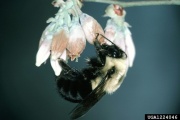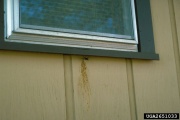Difference between revisions of "Carpenter bee"
Jump to navigation
Jump to search
m (Text replace - "== Authority ==" to "== Sources Checked for Data in Record ==") |
|||
| (One intermediate revision by the same user not shown) | |||
| Line 4: | Line 4: | ||
Any of several solitary bees of the genus Xylocopa found in most areas of the world. Carpenter bees bore tunnels in wood for their nests. They tend to prefer weathered and unpainted wood. Carpenter bees have shapes similar to bumblebees, but the top surface of their abdomen appears bare and shiny instead of hairy like bumblebees. Species include: - ''X. virginica'': Eastern half of US; 25 mm; female (black face), male (yellow face) - ''X. californica'': West coast of US; 20-25mm; both (metallic blue-green) - ''X. varipuncta'': West coast valleys: 18-20 mm; female (black with metallic reflections, male (light brown) - ''X. tabaniformis'': West coast mountains and foothills: 12-17 mm; both (black) | Any of several solitary bees of the genus Xylocopa found in most areas of the world. Carpenter bees bore tunnels in wood for their nests. They tend to prefer weathered and unpainted wood. Carpenter bees have shapes similar to bumblebees, but the top surface of their abdomen appears bare and shiny instead of hairy like bumblebees. Species include: - ''X. virginica'': Eastern half of US; 25 mm; female (black face), male (yellow face) - ''X. californica'': West coast of US; 20-25mm; both (metallic blue-green) - ''X. varipuncta'': West coast valleys: 18-20 mm; female (black with metallic reflections, male (light brown) - ''X. tabaniformis'': West coast mountains and foothills: 12-17 mm; both (black) | ||
| − | [[File:Carpenter_Bee_damage_forestryimages.org.jpg|thumb|Carpenter bee]] | + | [[File:Carpenter_Bee_damage_forestryimages.org.jpg|thumb|Carpenter bee damage]] |
== Synonyms and Related Terms == | == Synonyms and Related Terms == | ||
Xylocopa | Xylocopa | ||
| − | == | + | ==Physical and Chemical Properties== |
Size: 12 - 25 mm | Size: 12 - 25 mm | ||
| − | == | + | ==Resources and Citations== |
| + | * MuseumPest.net at [https://museumpests.net/ Link] | ||
| − | + | * Eric H. Smith, Richard C. Whitman, ''NPMA Field Guide to Sturctural Pests'', National Pest Management Association, Fairfax VA, 2005. | |
| − | |||
| − | |||
* ''The American Heritage Dictionary'' or ''Encarta'', via Microsoft Bookshelf 98, Microsoft Corp., 1998 | * ''The American Heritage Dictionary'' or ''Encarta'', via Microsoft Bookshelf 98, Microsoft Corp., 1998 | ||
| − | * ''Encyclopedia Britannica'', http://www.britannica.com Comment: "carpenter bee." | + | * ''Encyclopedia Britannica'', http://www.britannica.com Comment: "carpenter bee." Accessed 3 Feb. 2005 . |
| − | * Wikipedia | + | * Wikipedia: http://en.wikipedia.org/wiki/Carpenter_bee |
[[Category:Materials database]] | [[Category:Materials database]] | ||
Latest revision as of 15:10, 20 May 2022
Description
Any of several solitary bees of the genus Xylocopa found in most areas of the world. Carpenter bees bore tunnels in wood for their nests. They tend to prefer weathered and unpainted wood. Carpenter bees have shapes similar to bumblebees, but the top surface of their abdomen appears bare and shiny instead of hairy like bumblebees. Species include: - X. virginica: Eastern half of US; 25 mm; female (black face), male (yellow face) - X. californica: West coast of US; 20-25mm; both (metallic blue-green) - X. varipuncta: West coast valleys: 18-20 mm; female (black with metallic reflections, male (light brown) - X. tabaniformis: West coast mountains and foothills: 12-17 mm; both (black)
Synonyms and Related Terms
Xylocopa
Physical and Chemical Properties
Size: 12 - 25 mm
Resources and Citations
- MuseumPest.net at Link
- Eric H. Smith, Richard C. Whitman, NPMA Field Guide to Sturctural Pests, National Pest Management Association, Fairfax VA, 2005.
- The American Heritage Dictionary or Encarta, via Microsoft Bookshelf 98, Microsoft Corp., 1998
- Encyclopedia Britannica, http://www.britannica.com Comment: "carpenter bee." Accessed 3 Feb. 2005 .
- Wikipedia: http://en.wikipedia.org/wiki/Carpenter_bee

